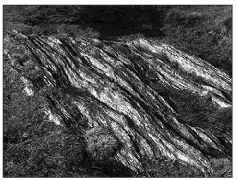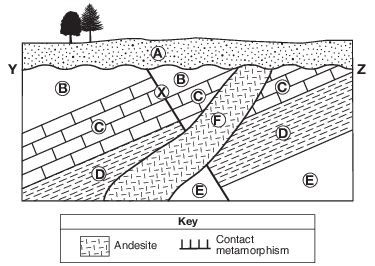Topic: Formation Classification And Application Of Rocks
Formation Classification And Application Of Rocks
Scoria is a type of rock that forms most directly from the process of
(1) solidification
(2) cementation
(3) erosion
(4) metamorphism
Obsidian’s glassy texture indicates that it formed
(1) slowly, deep below Earth’s surface
(2) slowly, on Earth’s surface
(3) quickly, deep below Earth’s surface
(4) quickly, on Earth’s surface
Most of the sediment that is compacted and later forms shale bedrock is
(1) clay
(2) silt
(3) sand
(4) pebbles

The rock that formed in the contact metamorphic zone between rock unit E and rock unit D is
(1) hornfels
(2) marble
(3) schist
(4) anthracite coal

This rock should be classified as
(1) an intrusive igneous rock
(2) an extrusive igneous rock
(3) a bioclastic sedimentary rock
(4) a clastic sedimentary rock

Which rock is most likely to form directly from rock material at a depth of 30 km and a temperature of 1000°C?
(1) quartzite
(2) scoria
(3) shale
(4) granite
Which types of surface bedrock are most likely found near Jamestown, New York?
(1) slate and marble
(2) quartzite and granite
(3) shale and sandstone
(4) schist and gneiss
The photograph below shows a large outcrop of rock composed primarily of visible crystals of mica, quartz, and feldspar.

Based on the composition and foliated texture, this rock can best be identified as
(1) marble
(2) schist
(3) slate
(4) anthracite coal

Which processes produced the brown siltstone layer in outcrops I and II?
(1) cooling and solidification of mafic lava at Earth’s surface
(2) cooling and solidification of felsic magma deep within Earth
(3) compaction and cementation of rock fragments ranging in size from 0.006 to 0.2 centimeter in diameter
(4) compaction and cementation of rock fragments ranging in size from 0.0004 to 0.006 centimeter in diameter
Carrara Marble
Carrara marble is named for the town of Carrara on the west coast of Italy. This dazzling white marble has been mined since the time of the ancient Romans and remains the major industry of the area today. The marble has many commercial uses, such as tombstones, countertops, tiles, and building stones. Its chemical purity, uniform color, and hardness make this marble an ideal material for artists who carve statues from rock. Major museums around the world have statues carved from Carrara marble.
The formation of Carrara marble began 200 million years ago when a great thickness of tiny shells was deposited at the bottom of a warm, shallow sea. Over time, burial and compaction of these sediments formed sedimentary rock primarily composed of pure calcite. Approximately 27 million years ago, tectonic forces caused this area of the seafloor bedrock to be deformed and metamorphosed, forming the Carrara marble. Uplift and erosion later exposed huge formations of this famous marble.
Identify the most likely sedimentary rock that formed when the sediments of tiny shells were buried and compacted. [1]
Allow 1 credit for limestone or coquina.

The beach consists of particles with diameters from 0.01 cm to 0.1 cm. Identify the sedimentary rock that will form when burial and cementation of these sediments occur. [1]
Allow 1 credit for sandstone.
A student on a field trip in New York State collected a sample of metamorphic bedrock containing bands of coarse-grained crystals of plagioclase feldspar, pyroxene, quartz, and mica.
Identify the metamorphic rock found by the student. [1]
Allow 1 credit for gneiss.
The graph below shows the depth and temperature conditions in Earth’s interior under which carbon becomes either the mineral graphite or the mineral diamond.

Compared to the depth and temperature conditions under which graphite forms, describe the difference in the relative depth and relative temperature conditions under which most diamonds form. [1]
Relative depth:
Relative temperature:
Allow 1 credit. Acceptable responses include, but are not limited to:
• Relative depth:
• — greater depth
• — deeper
• Relative temperature:
• — higher temperature
• — hotter

Identify one similarity and one difference between the igneous rocks andesite and diorite. [1]
Similarity:
Difference:
Allow 1 credit if both responses are correct. Acceptable responses include, but are not limited to:
• Similarity:
• — Both form at lower temperatures.
• — The rocks have similar mineral compositions.
• — The minerals have similar densities.
• — similar color
• Difference:
• — Andesite is extrusive and diorite is intrusive.
• — Andesite has a finer texture.
• — crystal size/grain size
• — cooling rates
• — environment of formation
Layer B is composed of clay-sized particles and layer E is composed of halite crystals. On the cross section in the image provided, fill in layer B and layer E on both sides of the fault with the correct sedimentary rock map symbols. [1]

Allow 1 credit if the symbols drawn are generally similar to those on the Earth Science Reference. Tables for shale in most of layer B and for rock salt in most of layer E. The symbols must be drawn on both sides of the fault, as shown.
• Note: Allow credit even if the symbols for shale and rock salt are not parallel to the other rock
• layers shown.
